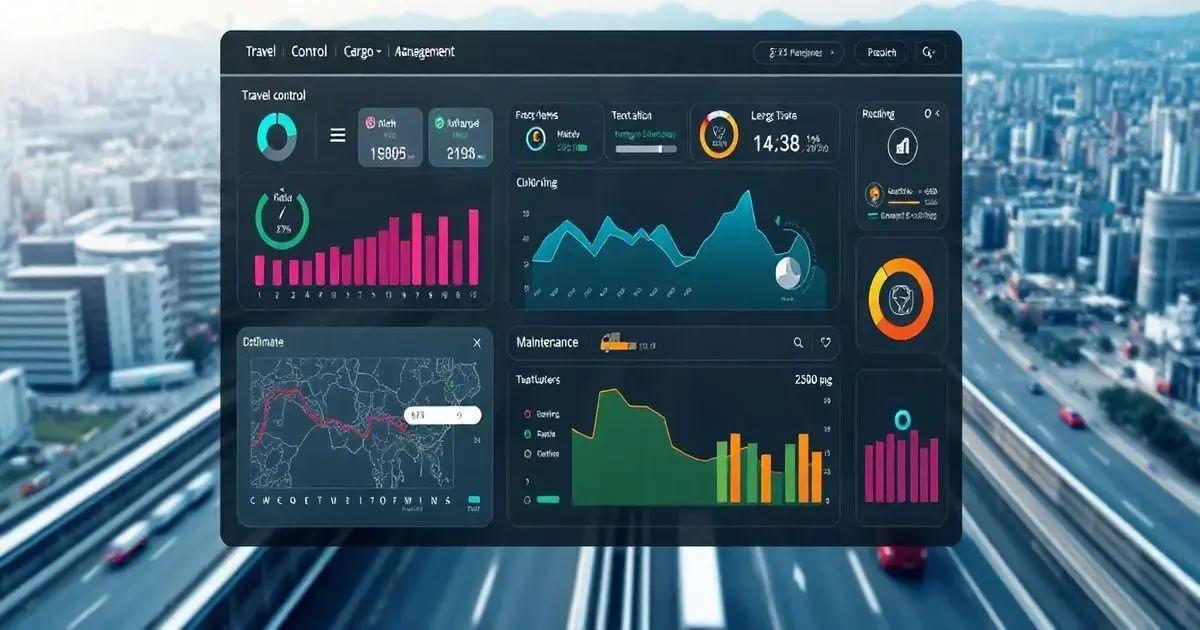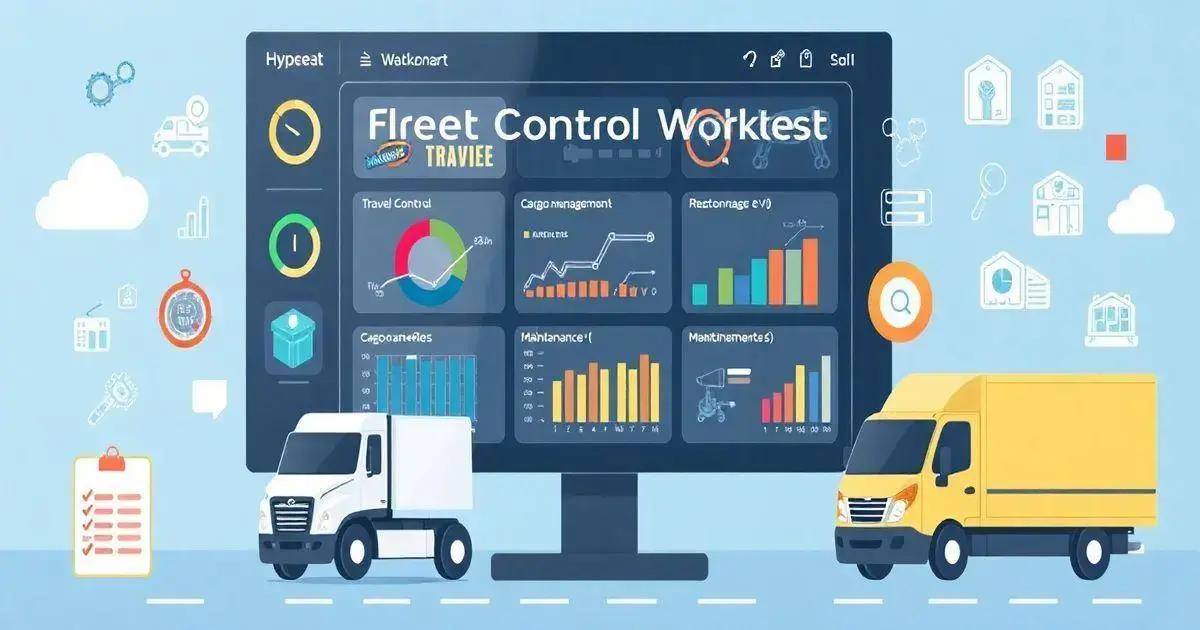Fleet Control Worksheet 7.0: Manage Your Fleet Efficiently Leave a comment
The Fleet Control Worksheet 7.0 is a powerful Excel tool designed to optimize fleet management by providing dashboards for vehicle performance, travel details, and maintenance schedules, along with features for tire management, expense tracking, and real-time performance analysis, ultimately enhancing accountability and reducing operational costs.
The Fleet Control Worksheet 7.0 is designed to simplify and enhance the management of your fleet operations. With features that include travel control, cargo management, and various maintenance trackers, this worksheet serves as a one-stop solution for fleet managers. In this post, we’ll explore its key functionalities and how it can streamline your processes.
Key Features of Fleet Control Worksheet 7.0
The Fleet Control Worksheet 7.0 comes packed with features that significantly enhance the efficiency of fleet management. Here are the key features that set this worksheet apart:
Comprehensive Dashboards: The worksheet includes initial dashboards that provide an overview of key performance indicators such as kilometers driven per vehicle, fuel consumption rates, and maintenance costs. This helps you to quickly gauge the overall health of your fleet.
Travel Control: Track all your trips in detail, including cargo management linked directly to each journey. This feature enables precise monitoring of travel expenses and helps in optimizing routes for cost-effectiveness.
Tire Control: The worksheet allows you to implement a tire management system that includes schedules for tire replacements based on kilometers driven. You can also track the status of each tire, helping ensure safety and reducing downtime.
Maintenance Tracking: Manage both preventive and corrective maintenance tasks with ease. The worksheet provides sections to record types of maintenance performed, costs incurred, and scheduling of future maintenance tasks, ensuring your vehicles are always in optimal condition.
Document Management: Keep track of all vehicle and driver documents with the built-in document control feature. This allows for organized storage and easy access to essential paperwork, reducing the risk of compliance issues.
Cost Analysis: Analyze your fleet’s operational costs over time with detailed reporting on fuel, maintenance, and other expenses. This feature aids in budget forecasting and cost-cutting strategies.
User-Friendly Interface: The design is intuitive and easy to navigate, making it accessible for users at any level of expertise. All data fields are clearly labeled, and the worksheet is compatible with various versions of Excel.
These features not only simplify fleet management tasks but also enhance decision-making through data-driven insights. With the Fleet Control Worksheet 7.0, managing your fleet has never been easier!

Initial Dashboards: Insights and Management
The Initial Dashboards in the Fleet Control Worksheet 7.0 are pivotal for gaining quick insights into your fleet’s performance. These dashboards serve as the command center for fleet managers, allowing you to visualize critical data at a glance. Here’s what you can expect:
Key Metrics Displayed
- Kilometers Driven by Driver: This metric tracks the distance each driver has traveled, helping you understand driver performance and efficiency.
- Kilometers per Vehicle: Monitor the total distance covered by each vehicle to identify usage patterns and assess whether particular vehicles are over or underutilized.
- Kilometers per Liter: This essential metric helps you evaluate fuel efficiency across your fleet. By tracking kilometers per liter, you can spot potential issues related to fuel consumption.
- Kilometers per Trip: Analyze the average distance traveled per trip to optimize routes and reduce costs.
- Average Consumption per Vehicle: This section allows you to see how much fuel each vehicle consumes on average, aiding in maintenance scheduling and fuel management.
- Total Maintenance Costs: Track the total expenses associated with preventive and corrective maintenance to ensure you’re staying within budget and identifying areas where costs can be reduced.
- Tires in Transit: Keep an eye on tires allocated for vehicles that are currently on the road, helping manage tire resources efficiently.
- Delayed Document Management: Monitor the status of vehicle and driver documents, flagging any that are overdue or require attention. This feature ensures compliance and avoids potential legal issues.
Benefits of Using Dashboards
These dashboards provide immediate insights, enabling fleet managers to make informed decisions quickly. With a clear overview of key performance indicators:
- Enhanced Decision-Making: With all the relevant data compiled in one place, you can make strategic decisions about resource allocation, route optimization, and maintenance schedules.
- Proactive Management: The dashboards highlight areas that may require immediate attention, allowing for proactive management rather than reactive fixes.
- Increased Accountability: By tracking metrics like kilometers per driver and vehicle, you enforce accountability amongst your team, promoting better performance and efficiency.
In conclusion, the initial dashboards of the Fleet Control Worksheet 7.0 are not just a collection of data—they are vital tools that empower you to manage your fleet with precision and foresight. Embracing these insights can lead to significant improvements in operational effectiveness.
Travel and Cargo Control: A Detailed Look
The Travel and Cargo Control section of the Fleet Control Worksheet 7.0 is designed to provide a comprehensive overview of all journeys undertaken by your fleet, ensuring that every aspect of travel and cargo management is meticulously tracked.
Here’s a closer look at what this feature entails:
Key Features of Travel and Cargo Control
- Trip Scheduling: Easily plan and schedule trips for each vehicle within your fleet. This feature allows you to assign trips to drivers and vehicles, helping to ensure efficiency and avoid scheduling conflicts.
- Cargo Management: Track details about the cargo being transported, including weight, type, and delivery destinations. This capability ensures that you can manage loads effectively and prevent overloading vehicles.
- Expense Tracking: Keep a detailed record of all travel-related expenses incurred during trips. This includes fuel costs, toll fees, and any additional expenses, giving you a clearer picture of the total cost associated with each journey.
- Real-Time Updates: Provide real-time updates on the status of each trip, including departure and arrival times, to enhance communication and coordination with drivers.
- Trip History: Maintain a comprehensive history of all trips taken, which is crucial for reviewing performance, identifying patterns, and analyzing data for future planning.
- Integration with Maintenance Logs: Link travel data with maintenance records to understand the impact of travel patterns on vehicle performance and wear-and-tear. This helps in better maintenance scheduling and cost management.
Benefits of Effective Travel and Cargo Control
Implementing robust travel and cargo control measures has several benefits for your fleet management:
- Improved Efficiency: By effectively scheduling and managing trips, you can maximize vehicle usage and reduce idle time, leading to significant cost savings.
- Enhanced Safety: Monitoring cargo loads and travel conditions ensures that your fleet adheres to safety regulations, minimizing the risk of accidents and ensuring the well-being of your drivers.
- Better Resource Allocation: With insights into trip frequency and cargo types, you can allocate resources more effectively, making informed decisions about fleet expansion or reduction.
- Data-Driven Decision Making: Having detailed records of trips and cargo management enables you to make more informed decisions about operations, pricing, and customer service enhancements.
In summary, the Travel and Cargo Control feature of the Fleet Control Worksheet 7.0 is essential for optimizing fleet operations, improving efficiency, and enhancing decision-making. By leveraging this tool, fleet managers can ensure that every trip is managed with precision and care, resulting in better overall performance for the fleet.

Tire and Maintenance Control Management
The Tire and Maintenance Control Management feature in the Fleet Control Worksheet 7.0 is a crucial aspect of effective fleet management, ensuring that vehicles are operating safely and efficiently through meticulous tracking of tire usage and maintenance schedules.
Let’s explore the components of this feature:
Tire Management
- Tire Identification: Each tire can be assigned a unique identifier, allowing for easy tracking of its usage history, performance, and status. This feature helps in managing individual tire lifecycle and ensures accountability.
- Change Schedule: Set and manage a tire change schedule based on kilometers driven. This proactive approach ensures that tires are replaced timely, preventing wear-related accidents and maintaining optimal performance.
- KM Remaining for Tire Change: Monitor the kilometers remaining before tire replacement is necessary. This feature provides alerts for upcoming tire changes, helping to keep your fleet safe and compliant with maintenance standards.
- Status Tracking: Track the status of each tire, including actions such as allocation to a vehicle, removal for repairs, scrapping, or maintenance. Maintaining an up-to-date status helps in efficient resource allocation and management.
Maintenance Control
- Preventive Maintenance Scheduling: Schedule preventive maintenance tasks based on vehicle usage and manufacturer recommendations. This helps in reducing the likelihood of unexpected breakdowns and costly repairs.
- Maintenance Type Logging: Log all types of maintenance performed on each vehicle, whether preventive or corrective. Recording this information is essential for tracking expenses and assessing vehicle condition over time.
- Cost Management: Analyze maintenance costs to identify trends and potential areas for savings. Understanding where money is spent can lead to better budgeting and decision-making regarding vehicle acquisitions or replacements.
- Maintenance Status Tracking: Keep track of the status of maintenance tasks, categorizing them as scheduled, completed, or delayed. This feature ensures that no maintenance tasks are overlooked, maintaining the reliability of your fleet.
Benefits of Tire and Maintenance Control Management
Implementing effective tire and maintenance controls brings numerous benefits to fleet management:
- Enhanced Safety: Regular tire inspections and timely maintenance significantly improve vehicle safety, reducing the risk of accidents due to tire failures or mechanical issues.
- Cost Efficiency: By monitoring tire wear and scheduling maintenance appropriately, fleets can reduce operational costs and extend the lifespan of vehicles, ultimately resulting in significant savings.
- Increased Fleet Reliability: A well-maintained fleet is less likely to experience breakdowns, ensuring that vehicles are available for use when needed, thus enhancing service delivery.
- Data-Driven Insights: Access to maintenance and tire data allows fleet managers to make informed choices about repairs, replacements, and overall fleet strategies.
In conclusion, the Tire and Maintenance Control Management aspect of the Fleet Control Worksheet 7.0 is essential for ensuring that fleet vehicles are well-maintained and safe for operation. By leveraging these tools, fleet managers can enhance overall productivity, safety, and cost-effectiveness of their operations.
User Guide: How to Install and Use the Worksheet
The User Guide for the Fleet Control Worksheet 7.0 is designed to help you install and effectively use the worksheet to manage your fleet operations. Follow the steps below to get started:
Installation Instructions
- Download the Worksheet: Visit the official website and click on the download link for the Fleet Control Worksheet 7.0. The file will be in Excel format (.xlsx).
- Save the File: Choose a location on your computer where you would like to save the worksheet. Make sure to remember this location for easy access later.
- Open Excel: Launch Microsoft Excel on your computer. The worksheet is compatible with Excel versions 2007 and newer, running on Windows 7, 8, 8.1, or 10.
- Open the Worksheet: Navigate to the location where you saved the file and double-click on the Fleet Control Worksheet to open it in Excel.
- Enable Editing: If prompted, click on the ‘Enable Editing’ button to allow modifications to the worksheet.
Setting Up the Worksheet
- Input Initial Data: Begin by entering your fleet details, including vehicle types, driver information, and initial maintenance records. This foundational data is essential for effective tracking and management.
- Customize Settings: Adjust any necessary settings based on your fleet’s specific needs. This may include modifying formulas, adjusting parameters, or setting up additional categories for tracking.
- Familiarize Yourself: Spend some time exploring the various tabs and sections of the worksheet. Understanding where to find specific information will enhance your efficiency.
Using the Worksheet
- Track Travel and Cargo: Use the designated sections to log each trip and its associated cargo details. Make sure to keep this information updated to maintain accurate records.
- Monitor Tire and Maintenance Control: Regularly update the tire management and maintenance logs. Input any repairs or maintenance tasks completed to ensure your fleet is always in optimal condition.
- Analyze Dashboards: Regularly review the dashboards to gain insights into your fleet’s performance. Utilize the data to make informed decisions regarding fleet operations, maintenance schedules, and budgeting.
- Save Your Progress: After making any entries or changes, save the worksheet frequently to avoid losing any important data. Consider creating regular backups of your data for added security.
Support and Troubleshooting
If you encounter any issues while installing or using the worksheet, refer to the FAQs section of the website for assistance. Additionally, you can reach out for technical support via email or WhatsApp for personalized help.
By following this user guide, you can ensure a smooth installation and effective use of the Fleet Control Worksheet 7.0. This powerful tool will help optimize your fleet management processes and improve overall efficiency.
Conclusion
In summary, the Fleet Control Worksheet 7.0 is an invaluable tool for fleet managers looking to enhance their operations.
With its comprehensive features for travel and cargo control, tire and maintenance management, and insightful dashboards, this worksheet empowers you to make informed decisions that drive efficiency and safety.
By implementing this worksheet, you gain the ability to not only monitor your fleet’s performance in real-time but also to proactively manage maintenance and scheduling, ultimately reducing costs and increasing productivity.
Whether you’re tracking kilometers driven, managing maintenance schedules, or analyzing fuel consumption, the Fleet Control Worksheet 7.0 provides the structure and insights necessary for effective fleet management.
Embrace the power of organized fleet management with this user-friendly Excel tool, and take the first steps towards optimizing your operations today!
FAQ – Frequently Asked Questions about Fleet Control Worksheet 7.0
What software is required to use the Fleet Control Worksheet 7.0?
The Fleet Control Worksheet 7.0 is compatible with any version of Microsoft Excel from 2007 onwards, running on Windows 7, 8, 8.1, or 10.
Can I install the worksheet on multiple computers?
Yes, you can install and use the Fleet Control Worksheet on as many computers as you need, as it is not restricted to a single device.
Are there any hidden fees associated with using the worksheet?
No, the purchase of the worksheet is a one-time payment, and there are no monthly or additional fees.
How can I get support if I encounter issues with the worksheet?
Technical support is available via email or WhatsApp, typically from Monday to Friday, between 9 am and 4 pm. You can also refer to the FAQs on the website for common issues.
Can I modify the worksheet to suit my specific needs?
Yes, the worksheet is fully unlocked, allowing you to make changes and modifications as needed for your fleet management requirements.
What should I do if I need to format my computer?
You do not need to repurchase the worksheet. Simply save the program to a USB flash drive or download it again from your email.

